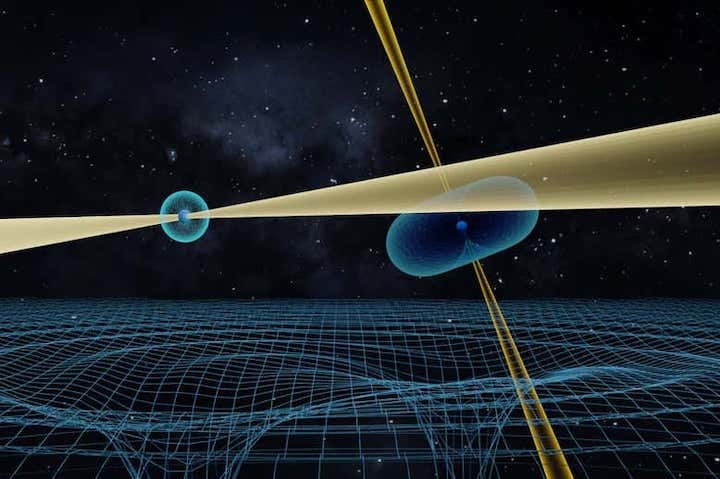15.12.2021
After monitoring a pair of pulsars in tight orbit around one another for 16 years, astronomers conclude that their behaviour is consistent with Einstein’s predictions

Artistic impression of the double system, where two active pulsars orbit each other in just 147 minutes
Michael Kramer/MPIfR
Einstein’s famous theory of general relativity has passed its most stringent test to date. After 16 years of observing a pair of pulsars – highly compact neutron stars that emit beams of radio waves from their poles – researchers saw relativistic effects that have previously only been predicted by the theory.
General relativity describes the effect of gravity on space-time. “If we have something that’s really massive, it’ll warp the space-time around it to a greater extent than something that’s less massive,” says Robert Ferdman at the University of East Anglia in the UK.
This means for extremely massive bodies, such as neutron stars, general relativity predicts that light will be bent markedly around them as photons follow the warped path of space-time. What’s more, when neutron stars accelerate, which can happen if two of them are spiralling around one another, they will emit gravitational waves – ripples in space-time – that will cause their orbits to shrink as they lose energy. This is known as orbital decay.
Now, Ferdman and his colleagues have observed both of these theoretical predictions on two pulsars, known as PSR J0737−3039A/B. These orbit each other in just 147 minutes at speeds of up to 1 million kilometres per hour. As they orbit, one of the pulsars is simultaneously rotating around its axis about 44 times every second, while its companion rotates once every 2.8 seconds. Every time each pulsar rotates, we receive a blast of radio beams on Earth.
“Those pulses will arrive extremely regularly unless there’s something in the way or some astrophysical phenomenon that’s causing a delay in those arrivals,” says Ferdman.
Using seven radio telescopes in Australia, the US and Europe, the researchers monitored the double pulsar system between its discovery in 2003 until 2019.
They found that the radio pulses consistently arrived later than expected, and calculated this was because they were being deflected at an angle of 0.04 degrees due to the strong space-time curvature around the two stars. This is the first experimental evidence of such a high curvature, according to Ferdman’s team.
The researchers also found that the pulsars underwent orbital decay due to the emission of gravitational waves. They could detect the energy carried by these waves with a precision 1000 times better than is possible with direct gravitational wave detectors on Earth, such as the LIGO detectors in the US.
“This is the most stringent test to date of Einstein’s theory, and it sets the bar to which future experiments must [operate] in terms of precision in order to put general relativity to the test with any significance,” says Ferdman.
“[General relativity] is the best theory we have of gravity, but we know because of the incompatibility with quantum mechanics and the standard model [of particle physics], it’s not the final word,” he says.
Quelle: NewScientist
